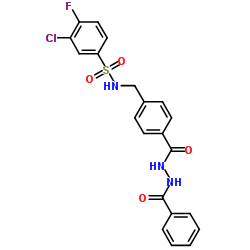TCN 201

TCN 201结构式

|
常用名 | TCN 201 | 英文名 | TCN 201 |
|---|---|---|---|---|
| CAS号 | 852918-02-6 | 分子量 | 461.894 | |
| 密度 | 1.4±0.1 g/cm3 | 沸点 | N/A | |
| 分子式 | C21H17ClFN3O4S | 熔点 | N/A | |
| MSDS | 美版 | 闪点 | N/A | |
| 符号 |

GHS07 |
信号词 | Warning |
TCN 201用途TCN 201 是一种有效的,选择性和非竞争性的 GluN1/GluN2A NMDAR 拮抗剂。 TCN 201的拮抗作用取决于 GluN1 激动剂的浓度。TCN201 可以对含有天然 GluN2A 的 NMDAR 群体进行药理学鉴定。 |
| 中文名 | 4-[[[(3-氯-4-氟苯基)磺酰基]氨基]甲基]苯甲酸 2-苯甲酰基酰肼 |
|---|---|
| 英文名 | N-[[4-(benzamidocarbamoyl)phenyl]methyl]-3-chloro-4-fluorobenzenesulfonamide |
| 英文别名 | 更多 |
| 描述 | TCN 201 是一种有效的,选择性和非竞争性的 GluN1/GluN2A NMDAR 拮抗剂。 TCN 201的拮抗作用取决于 GluN1 激动剂的浓度。TCN201 可以对含有天然 GluN2A 的 NMDAR 群体进行药理学鉴定。 |
|---|---|
| 相关类别 | |
| 靶点 |
NMDAR[1] |
| 体外研究 | tcn201(10μM)对卵母细胞中GluN1/GluN2B NMDAR介导的电流仅产生轻微的抑制作用[1]。tcn201(10-30μM)对NMDAR介导的反应的拮抗作用是亚型和甘氨酸依赖的,在卵母细胞中比tcn213更有效[1]。tcn201(0.1-100μM)在卵母细胞中不能完全阻断NMDAR介导的反应[1]。tcn201(10μM)对NMDAR介导电流的拮抗作用与其ifenprodil敏感性呈负相关[1]。tcn201(1-9μM)抑制鸡视网膜皮质扩散抑制(CSD)[2]。 |
| 体内研究 | TCN-201(10mg/kg;i.p.)对大鼠CSD-g血氧水平依赖性(BOLD)反应无效[3]。 |
| 参考文献 |
| 密度 | 1.4±0.1 g/cm3 |
|---|---|
| 分子式 | C21H17ClFN3O4S |
| 分子量 | 461.894 |
| 精确质量 | 461.061218 |
| PSA | 116.24000 |
| LogP | 4.13 |
| 折射率 | 1.625 |
| 储存条件 | 2-8°C |
| 符号 |

GHS07 |
|---|---|
| 信号词 | Warning |
| 危害声明 | H315-H319-H335 |
| 警示性声明 | P261-P305 + P351 + P338 |
| 危害码 (欧洲) | Xi |
| 风险声明 (欧洲) | 22-36/37/38 |
| 安全声明 (欧洲) | 26-36/37/39 |
| 危险品运输编码 | NONH for all modes of transport |
|
Sensitivity of N-methyl-D-aspartate receptor-mediated excitatory postsynaptic potentials and synaptic plasticity to TCN 201 and TCN 213 in rat hippocampal slices.
J. Pharmacol. Exp. Ther. 352(2) , 267-73, (2014) Whereas ifenprodil has been used as a selective GluN1/GluN2B (NR1/NR2B, B-type) receptor antagonist to distinguish between GluN2B (NR2B) and GluN2A (NR2A)-containing N-methyl-d-aspartate receptors (NM... |
|
|
PAR1-activated astrocytes in the nucleus of the solitary tract stimulate adjacent neurons via NMDA receptors.
J. Neurosci. 35(2) , 776-85, (2015) Severe autonomic dysfunction, including the loss of control of the cardiovascular, respiratory, and gastrointestinal systems, is a common comorbidity of stroke and other bleeding head injuries. Previo... |
|
|
Extrasynaptic glutamate release through cystine/glutamate antiporter contributes to ischemic damage.
J. Clin. Invest. 124(8) , 3645-55, (2014) During brain ischemia, an excessive release of glutamate triggers neuronal death through the overactivation of NMDA receptors (NMDARs); however, the underlying pathways that alter glutamate homeostasi... |
| Benzoic acid, 4-[[[(3-chloro-4-fluorophenyl)sulfonyl]amino]methyl]-, 2-benzoylhydrazide |
| tcn 201 |
| qcr-22 |
| N-{4-[(2-Benzoylhydrazino)carbonyl]benzyl}-3-chloro-4-fluorobenzenesulfonamide |


